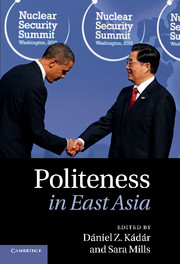Book contents
- Frontmatter
- Contents
- Notes on contributors
- Foreword
- Acknowledgements
- Abbreviations
- 1 Introduction
- Part I Politeness in East Asia: Theory
- Part II Politeness in East Asia: Practice
- 6 Politeness in China
- 7 Politeness in Japan
- 8 Politeness in Korea
- 9 Politeness in Vietnam
- 10 Politeness in Singapore
- 11 Epilogue: Culture and norms in politeness research
- Notes
- Bibliography
- Index
10 - Politeness in Singapore
from Part II - Politeness in East Asia: Practice
Published online by Cambridge University Press: 07 September 2011
- Frontmatter
- Contents
- Notes on contributors
- Foreword
- Acknowledgements
- Abbreviations
- 1 Introduction
- Part I Politeness in East Asia: Theory
- Part II Politeness in East Asia: Practice
- 6 Politeness in China
- 7 Politeness in Japan
- 8 Politeness in Korea
- 9 Politeness in Vietnam
- 10 Politeness in Singapore
- 11 Epilogue: Culture and norms in politeness research
- Notes
- Bibliography
- Index
Summary
Introduction
This chapter explores Singapore Chinese politeness as institutionally and locally situated politic behaviour, and investigates instances in which politeness might be at issue in terms of the familial, political and institutional structures that sustain varying notions of politic behaviour. In doing so, the chapter also reveals the complex and sometimes differing pragmatic practices in various social interactions that take place in today's Singapore. The chapter begins by providing a historical background of Singapore and then gives an overview of the literature on politeness in Singapore. This is followed by an account of the key concepts, norms and philosophies that govern the Chinese-speaking people in Singapore, and then a section which provides specific examples to explain Singapore Chinese politeness and impoliteness.
Singapore is an island nation located at the southern tip of the Malay Peninsula, 137 kilometres (85 miles) north of the Equator, south of the Malaysian state of Johor and north of Indonesia's Riau Islands. With an area of 704 kilometres, it is one of the few remaining city-states in the world and the smallest country in Southeast Asia. The name Singapura came from the Malay words singa ‘lion’ and pura ‘city’, which were in turn derived from the Sanskrit words simha and puram respectively. According to the Malay Annals, the name Singapura was given by a fourteenth-century Sumatran prince named Sang Nila Utama, who, landing on the island after a thunderstorm, spotted an auspicious beast on the shore that his chief minister identified as a lion. Recent studies of Singapore indicate that lions have never lived there, and the beast seen by Sang Nila Utama was likely to have been the Malayan Tiger.
- Type
- Chapter
- Information
- Politeness in East Asia , pp. 226 - 251Publisher: Cambridge University PressPrint publication year: 2011
- 2
- Cited by

